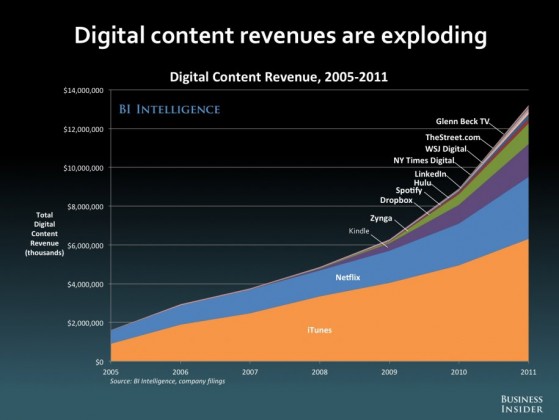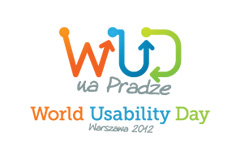Źródło: The future of digital, Henry Blodget, Business Insider
Archives for November 2012
Prezentacja (z WUD) – User Experience w Agencji
Polecam.
Źródło: User Experience w agencji ,Maciej Lipiec, Prezentacja na World Usability Day Kraków 2012
Wyrwane z kontekstu – Video Stream Quality Impacts Viewer Behavior
Bardzo, bardzo ciekawe badanie wykonane przez Akamai i naukowca z University of Massachusetts, dowodzący, że w przypadku serwisów serwujących treści wideo, cierpliwość użytkowników oczekujących na rozpoczącie odtwarzania utworu zaczyna się wyczerpywać już w ciągu 2 sekund.
We study the impact of video stream quality on viewer behavior in a scientific data-driven manner by using exten- sive traces from Akamai’s streaming network that include 23 million views from 6.7 million unique viewers. We show that viewers start to abandon a video if it takes more than 2 seconds to start up, with each incremental delay of 1 second resulting in a 5.8% increase in the abandonment rate. Further, we show that a moderate amount of interruptions can decrease the average play time of a viewer by a significant amount. A viewer who experiences a rebuffer delay equal to 1% of the video duration plays 5% less of the video in comparison to a similar viewer who experienced no rebuffering. Finally, we show that a viewer who experienced failure is 2.32% less likely to revisit the same site within a week than a similar viewer who did not experience a failure.
Źródło: Video Stream Quality Impacts Viewer Behavior: Inferring Causality Using Quasi-Experimental Designs, S. Shunmuga Krishnan & Ramesh K. Sitaraman, ACM
Wyrwane z kontekstu – How to simulate context of use in-lab
If you have a product or service where context of use directly impacts on the user experience, consider these top tips when simulating context of use in the lab:
- Let users experience the whole experience – Don’t force users down one single path. Instead allow users to explore the entirety of a system or site, even if parts are less developed
- Consider physical factors – think about the physical set up e.g. the height, distance, angle and physical restrictions of the device/interface that will be used
- Consider sensory factors which may distract the user from the task at hand and think about which of these can be brought into the lab
- Consider factors which may normally enhance an experience – for example offer drinks and snacks when testing something designed to be used by a group of friends on a Friday night.
Źródło How to simulate context of use in-lab, Nicole Harlow, Foolproof
Prezentacja – How to ask about satisfaction on a survey
Bardzo dobra (jak zwykle ;) prezentacja Caroline Jarrett! Polecam.
Źródło: How to ask about satisfaction on a survey, Caroline Jarrett, Slideshare
Wyrwane z kontekstu – The benefits of digital by default
Digital by default services are more efficient and more convenient for users. Our initial testing comparing GOV.UK to the previous Directgov and Businesslink.gov.uk sites shows a more positive rating on both ease of use (93% compared with 75% before) and speed (80 seconds as opposed to 120 seconds to undertake comparable transactions).
Government will save money if demand for higher cost channels decreases. A 2012 SOCITM study across 120 local councils estimated that the cost of contact for face to face transactions averages £8.62, for phone £2.83, but for web only 15 pence. The Digital Efficiency Report found that the average cost of a central government digital transaction can be almost 20 times lower than the cost of telephone and 50 times lower than face to face.
Źródło: Government Digital Strategy, praca zbiorowa, UK Cabinet Office
Wyrwane z kontekstu – How data analysis helped Obama win
The campaign rigorously tested donation-related words such as Donate Now, Please Donate, Why Donate, Donate and Get A Gift, Contribute. They found that “Why Donate” was by far the poorest performing phrase. “Donate And Get A Gift” worked best for those who had not yet signed up for the campaign. “Please Donate” worked best for those who had already signed up. “Contribute” worked best for those who had signed up and already made at least one financial donation.
If the 2008 campaign was rigorous, the 2012 campaign was scientific. As one official told TIME magazine, the era of “guys sitting in a back room smoking cigars, saying ‘We always buy 60 Minutes’” is over.” As TIME summarized, “In politics, the era of big data has arrived.” If the worst way to try to win a political campaign is to have five smart people in a room smoking cigars and pontificating, then the worst way to manage an online presence if to have five smart people in a room drinking lattes and opinionating.
“We are going to measure every single thing in this campaign,” campaign manager Jim Messina said after taking the job. According to TIME, “He hired an analytics department five times as large as that of the 2008 operation, with an official “chief scientist” for the Chicago headquarters named Rayid Ghani, who in a previous life crunched huge data sets to, among other things, maximize the efficiency of supermarket sales promotions.”
Wyrwane z kontekstu – Audience and Disclosure Regulation in Online Social Network Sites
We found that students who were worried about privacy were less likely to start using social network sites. Once the students did make the jump, they managed their concerns about unwanted audiences by adjusting their usage of nicknames on Myspace and through adjusting the visibility of their profiles on Facebook and Myspace but not by regulating their levels of disclosure, except for the case of phone numbers.
We also found that the perceived likelihood that future employers, government, corporations, or romantic partners would see their profile did not have an impact on the visibility of their profiles. The students also did not find any of those scenarios very likely, except for future romantic partners. (A possible romantic partner looking at the profile, rather than being a cause for concern,may actually be an aim for many of the students.)
Źródło: Can You See Me Now? Audience and Disclosure Regulation in Online Social Network Sites, Zeynep Tufekci, University of Maryland, Baltimore County
Listopad – miesiąc spotkań z użytecznością, eyetrackingiem i user experience
Tegoroczny listopad pod względem ilości organizowanych imprez będzie naprawdę bogaty. Czego możemy się spodziewać? Poza świętowaniem World Usability Day (w tym roku poświęconemu usługom finansowym), odbędzie się konferencja poświęcona eyetrackingowi i UX Camp w Trójmieście i comiesięczne spotkanie CHI Polska.
3Camp Usability – Trójmiasto
6 listopada w Trójmieście odbędzie się coroczna edycja 3campu poświęcona użyteczności. Wśród prelegentów będa przedstawiciele Wirtualnej Polski, Nokautu (Krzysztof Piwowar), Polskapresse i Young Digital Poland.
Spotkanie rozpocznie się o godzinie 18.00 i będzie miało miejsce w Gdańskim Parku Naukowo-Technologiczny, przy ul. Trzy Lipy 3. Uczestnictwo wymaga wcześniejszej rejestracji.
Więcej szczegółów: wpis w serwisie 3camp poświęcony wydarzeniu
WUD na Pradze
8 listopada odbędzie się pierwsza (po przerwie) warszwska edycja World Usability Day. Wśród prelegentów będą m.in. Wiesław Kotecki, Paulina Rzymska, Justyna Karamuz, Paweł Haltof, Agata Pasikowska, Joanna Kwiatkowska i Tomek Skórski. Jesteśmy patronem medialnym tego wydarzenia.
Spotkanie odbędzie się na SWPS na Pradze i zacznie się o godzinie 18-tej.
Szczegóły: strona WWW wydarzenia, strona wydarzenia na Facebooku.
WUD Silesia
 10 listopada w Katowicach odbędzie trzecia edycja WUD Silesia. To impreza organizowana z największym rozmachem, najbardziej profesjonalnie i w dodatku razem z warsztatami! Serwis UXLabs (jak pewnie zauważyliście) jest patronem WUD Silesia, więc 10 listopada będziemy w Centrum Informacji Naukowej gdzie odbywa się to wydarzenie. Program wydarzenia jest dość urozmaicony i ma przyciągnąć zarówno specjalistów jak i laików.
10 listopada w Katowicach odbędzie trzecia edycja WUD Silesia. To impreza organizowana z największym rozmachem, najbardziej profesjonalnie i w dodatku razem z warsztatami! Serwis UXLabs (jak pewnie zauważyliście) jest patronem WUD Silesia, więc 10 listopada będziemy w Centrum Informacji Naukowej gdzie odbywa się to wydarzenie. Program wydarzenia jest dość urozmaicony i ma przyciągnąć zarówno specjalistów jak i laików.
Szczegóły: strona WWW wydarzenia, strona wydarzenia na Facebooku.
WUD Kraków
 O WUD Kraków wiadomo póki co, że odbędzie się 24 listopada w Krakowie.
O WUD Kraków wiadomo póki co, że odbędzie się 24 listopada w Krakowie.
Więcej szczegółów na pewno pojawi się na stronie wydarzenia na Facebooku.
I Polska Konferencja Eyetrackingowa – Lublin
30 listopada 2012 roku Katedra Psychologii Eksperymentalnej Katolickiego Uniwersytetu Lubelskiego razem z firmą Neuro Device – polskim dystrybutorem SMI zaprasza na I Polską Konferencję Eyetrackingową, “Eyetracking w badaniach społecznych i humanistycznych. Teoria – metoda – aplikacja”. Program wydarzenia wygląda na bardziej naukowy niż popularyzatorski, a sam udział jest w konferencji jest płatny (100/50 PLN).
Dodatkowe informacje znajdują się na stronie konferencji.
WUD Wrocław
Spotkanie posiadające najdłuższą tradycję – World Usability Day Wrocław (zaplanowane na 8 listopada) zostało niestety w tym roku odwołane z powodu braku sponsorów. Więcej szczegółów na stronie wydarzenia.








Recent Comments